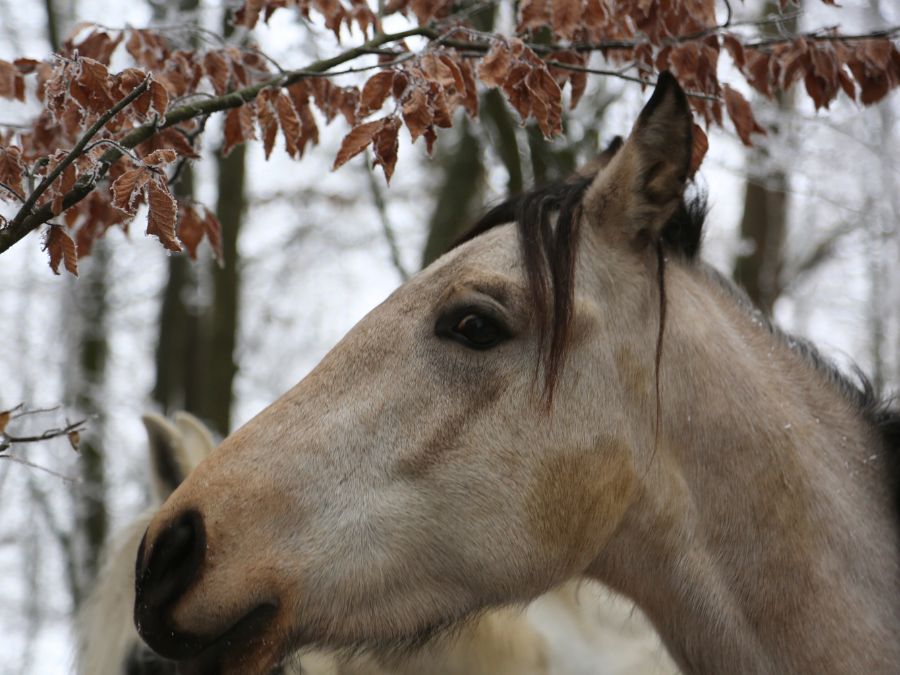
Horses have 35,000 taste buds
(Humans only 9000) and can feel the pressure of a nylon fiber weighing a thousandth of a gram on the withers. That’s the weight of three grains of sand.
Source: Janet L. Jones: Horse Brain – Human Brain
Horse training for the good of the horse” isn’t that what everyone wants? Yes and no. While the number of conscious riders and instructors of different riding styles is steadily increasing, certain dogmas in riding unfortunately persist. Starting with militant riding lessons that are supposed to lead to a “swinging” rider’s seat with command-like instructions, through to errors such as that horses “go against the reins” if you have not pulled hard enough at the front and pushed hard enough at the back. Teaching riding and training horses for the benefit of the horse means, as a trainer, seeing the rider and the horse as a whole and acting accordingly.
So the daily constitutions, previous histories, body proportions, acquired talents, connections between individual aspects, even the awareness that you simply cannot know all the backgrounds, should be included in every impulse that is set. You might think this is a high standard – but shouldn’t it apply wherever you work with living beings?
Due to a lack of exercise, which usually prevails even in the best trail keeping compared to nature, it is also our task to train strength and balance in our own horse so that it can optimally balance the fluctuating rider’s weight at all turns and speeds or, if it is not ridden, remain fit into old age. Perhaps it is good to realize here that this process is about what we once called assembly and not extraction or squeezing out. Gathering, collecting – centering oneself. Gathering, something that is stimulated by an inner posture or an external impulse, but in any case focuses attention inwards. Carefully selected exercises strengthen the muscles close to the horse’s trunk instead of hasty, leveraged compensatory movements, which would lead to premature wear and tear of the bone and tissue structures.
How can I help a horse to center itself? How can I really understand giving help as a help, a true support and not as an application of coercion? Can I “force” a pedestrian who is standing thoughtfully on the sidewalk to cross the street? Yes, I can try it, but depending on the personality of the pedestrian, I can expect to encounter mild to severe resistance. This resistance to crossing a boundary manifests itself in the horse by “tightening up” and is a reaction to the compelling aids. However, “tightening up” can also mean an original lack of muscular strength, if you imagine how heavy a person can be in your arms when crossing the road if they lack the necessary strength to walk.
Similarly, an inadequately trained riding horse tries to balance itself on the reins against the increased centrifugal forces caused by the rider – in this case, it needs biomechanically sensible auxiliary impulses from humans for gradual collection in order to keep it healthy in the long term. However, these aids have nothing to do with counter-pull on the reins or pressure on the leg, but with very subtle shifts in balance within the scope of the horse’s situational possibilities. If I apply unexpectedly firm pressure to a living tissue, it will protect itself, harden and consequently block movement or at some point no longer react at all. If I give the horse an easily executable directional impulse that stops immediately at the slightest initiative, it will accept the help as assistance. If the directional idea suggested by the rider was also sensible, it will gradually develop inner strength and carrying power. After a while, this is the feeling in the calf or on the fingers of the rein hand where the horse moves as light as a feather because it has developed inner strength.
In terms of the holistic nature of horse-friendly training, it is logical that this inner muscular strength is also closely linked to the horse’s “inner attitude” – his self-confidence – and that building up one strength also strengthens the other and vice versa. All confidence-building exercises and impulses for gradual collection are presented in small steps in order to maximize the horse’s sense of achievement. Liveliness of mind and movement are mutually dependent, which is why the horse’s courage and initiative should always be encouraged, as long as this does not result in dangerous situations for humans. These make the horse proud and radiant and are immediately reflected in the quality of movement.
All of this makes up training for the benefit of the horse, which focuses on both the mental and physical well-being of the horse. Riding competence here also consists of being able to read the horse’s behavior and movement, knowing which impulse helps the horse at any given moment and how much of it. This requires a holistic view, empirical knowledge, empathy, knowledge of biomechanical relationships and the conviction that the horse reacts appropriately in every situation and that it is always up to us to ensure its success and health.

